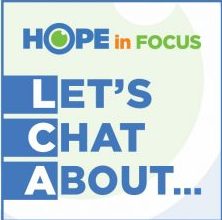Let’s Chat About…Advancing Treatments into Clinical Trials with Ben Shaberman
Innovative funding initiatives created by the Foundation Fighting Blindness are accelerating research advances to find treatments for Leber congenital amaurosis (LCA) and other rare inherited retinal diseases (IRDs).
Preclinical research involving animal models often gets stuck in early phases because no funding exists to move into clinical trials where developing treatments can be evaluated on people and advanced toward regulatory approval.
“The science is there; it’s the money that’s needed to fund the clinical trials, especially in later stages,” according to Ben Shaberman, the Foundation’s Senior Director of Scientific Outreach and Community Engagement.

Ben Shaberman
He appeared in a recent webinar episode of our Let’s Chat About online series, in which he detailed strategies driving retinal disease research.
Courtney Coates, our Director of Outreach and Development, moderated the episode, “Let’s Chat About… Advancing Treatments into Clinical Trials: Opportunities and Challenges,” featuring Shaberman, who has been with the Foundation about 17 years. You can view the session here.
Shaberman writes for the Foundation’s electronic and print publications, presents the latest scientific retinal research advancements at local and national events for patients and families, and conducts science training activities for staff and constituents.
He launched a podcast series last year called “Eye on the Cure” and enjoys collaborating with people one-on-one to help them understand their retinal disease and the research underway that could benefit them.
He also leads the company’s outreach to eye care professionals throughout the United States to help educate their patients about resources available to patients with low vision or blindness.
Shaberman earned a Master of Arts degree in writing from Johns Hopkins University, a Master of Science degree in systems management from the University of Maryland, and a Bachelor of Science degree in computer information science from Cleveland State University.
The Foundation is the world’s leading private funder of research on potential treatments and cures for inherited retinal degenerative diseases, including age-related macular degeneration. The nonprofit has raised more than $850 million to find cures for retinal diseases, identify more than 300 genes linked to them, and launch more than 40 clinical trials for potential treatments.
Foundation Funding Programs
Preclinical research or laboratory research done in academic research centers globally is expensive.
“But, when you are moving those emerging therapies from the labs, the cost goes up dramatically and that’s a big barrier for researchers,” Shaberman said. “It costs millions of dollars just to get in that clinical stage.”
That stage brings humans into the research, pulls in the U.S. Food and Drug Administration as a regulator and overseer, and requires submitting to the FDA required applications explaining the research and demonstrating the developing treatment’s safety and efficacy.
“That’s a really intensive process,” he said. “They (these early-stage therapies) may never see the light of day in a clinical trial because of all these issues.”
The Foundation created two programs to help drive projects to clinical stages.
The first, its Translational Research Acceleration Program (TRAP), helps scientists refine preclinical studies and accelerate research toward clinical trials to provide a robust pipeline of potential therapies to fight IRDs.
“TRAP helps researchers do some of that later stage work that will hopefully help them get to the clinical-trial doorstep,” Shaberman explained.
TRAP is funding a study at the Casey Eye Institute focusing on neuro-protective treatments to help reduce inflammation and other symptoms common to retinal diseases. Funding also supports Usher Syndrome Type 3a later-stage lab work.
The second program is the Foundation’s Retinal Degeneration Fund (RD Fund) and marks a step forward from TRAP because it invests in start-up companies. Like a venture capitalist, the investment is looking for a return, which instead of going into investors’ pockets, goes to the RD Fund to help projects in or advancing toward early-stage clinical trials.

“The ultimate goal is once you move something into a clinical trial and help those companies do that, if you can get some early encouraging signals, you can attract tens or hundreds of millions to fund that process.”
The RD Fund led the $19 million in seed financing to create Opus Genetics, the first spin-out company internally conceived and launched by the Fund to further the Foundation’s mission.
The new gene therapy company plans to target two forms of LCA: LCA13 (RDH12), which affects one in 288,000 people, and LCA5, which encodes the lebercilin protein and affects about one in 1.7 million people.
The RD Fund also helped advance ocular gene therapy research by Shannon Boye, PhD, and Sanford Boye, founders of Atsena Therapeutics.
BioBonds Congressional Legislation
Another initiative supported by the RD Fund, Hope in Focus, and two dozen more groups is a proposed Congressional Act designed to help researchers launch clinical trials for emerging treatments and gives hope for getting more treatments across the finish line for people living with a broad range of medical conditions, including rare retinal diseases.
This BioBonds legislation establishes loans up to $25 million to a researcher or company as an innovative way to finance early-stage clinical trials. The program would provide $10 billion annually for three years, and researchers would be required to repay the low-interest, government-backed loans.
Shaberman encouraged his webinar audience to go to the BioBonds website for more information and email him about supporting the proposal.
He said he has always been inspired by the courage of patients and families and their success in coping with challenging conditions. They often motivate friends to help with fundraising and get more people involved with advancing research. The stories coming out of the Foundation and Hope in Focus create connections between families and foster positivity and success.
He cited Hope in Focus for its support of the Foundation’s free genetic testing program to get a confirmed genetic diagnosis, a vital step in the journey toward understanding a person’s specific retinal disease caused by a gene mutation.
Fifteen years ago, a handful of trials were underway. Researchers now are working on more than 40 clinical trials.
“A lot has happened. It can never happen quickly enough, but we’re doing everything we can to accelerate the science, and, in the end, science takes time.”
